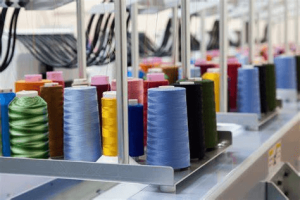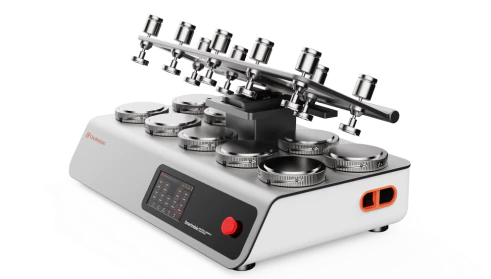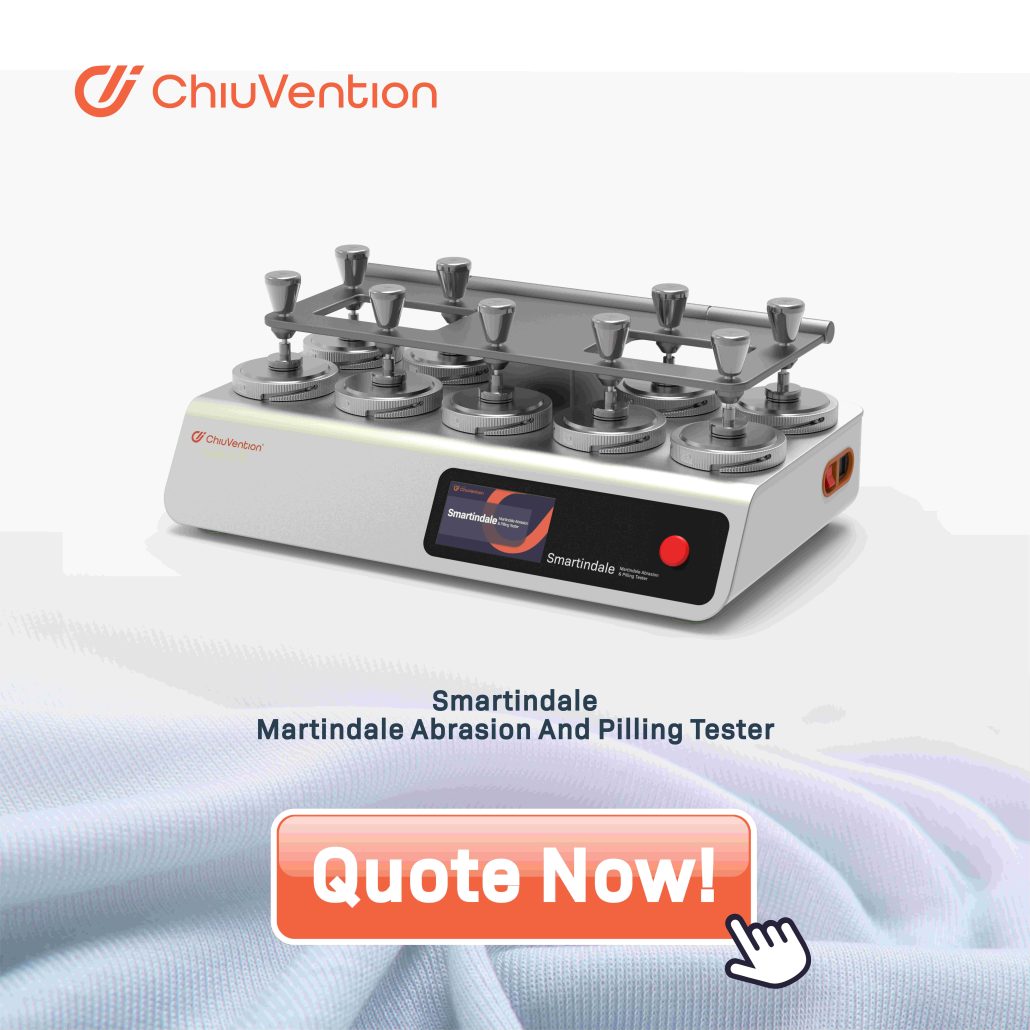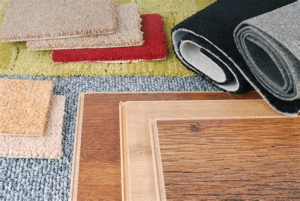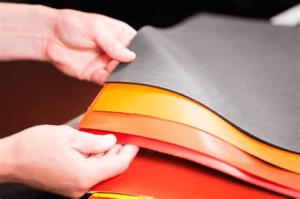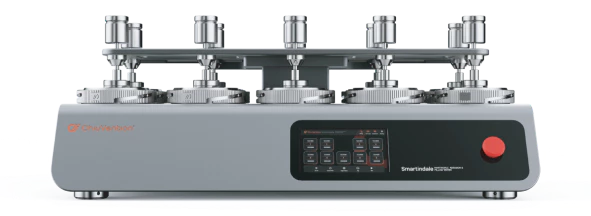1 Relevant Standards for Determination of Fabric Abrasion Resistance at Home and Abroad
The so-called abrasion refers to the phenomenon that fabrics are gradually damaged by repeated friction with another object. Abrasion resistance in textile is the characteristic of textile to resist abrasion. Practice has shown that abrasion in textiles is one of the main causes of damage to fabrics and has a direct impact on their durability. Therefore, many textiles are required to conduct abrasion testing, e.g. bed linen, duvet covers, pillowcases, sofa fabrics, floor coverings and some coated fabrics.
There are many ways to test abrasion of fabrics in real-world situations, the degree of wear is also very different, so the types of abrasion test methods include flat abrasion, flex abrasion, fold abrasion, turning abrasion, and others.
Flat abrasion, is to do plane friction on the specimen in a certain form of movement, until some kind of destructive features appear on the specimen, and the number of friction times is recorded as the index of abrasion resistance.
Flex abrasion, is to make the fabric specimen in the bending state by repeated friction and bending until the specimen breaks, record the number of times of friction, or test friction a certain number of times after the rate of decline in tensile strength.
Fold abrasion, is the fabric specimen will be folded, the specimen of the folded edge of the abrasion.
Turning abrasion, is the fabric specimen around the adhesive bonding, and weigh the specimen mass, and then into the inner blade, and different abrasive test cylinder.
When the test, the blade high-speed rotation, the specimen in the blade under the flip continuous friction, impact, bending, compression and tension and other roles, after a specified period of time, take out the specimen, and then weighed its quality, the smaller the loss of quality, that the fabric is more abrasion-resistant.
The above shows common fabric rub test methods. The relevant fabric abrasion testing standards at home and abroad are shown at below Table 3-21.
2 Textile Abrasion Resistance Testing Methods
On the determination of abrasion resistance textile standards, as shown in Table 3-21, there are many kinds and different methods. After years of unremitting research by textile standards and test workers of various countries, the textile abrasion test methods have become consistent, and basically formed the ISO 12947 as the standard method for the determination of abrasion resistance. The United Kingdom and other countries in the European Union have basically adopted the ISO test method completely. Although the United States and Japan have more abrasion resistance test methods, but with ISO 12947 series of abrasion resistance test methods consistent with the method of ASTM and JIS have been proclaimed. The Chinese standards on abrasion resistance include GB/T 21196 series of abrasion resistance determination and abrasion resistance test methods for woollen fabrics, among which GB/T 21196 basically adopts the test methods of ISO 12947.
2.1 Comparison of different fabric abrasion testing methods
Comparison of abrsion resistance test methods in each standard is shown in Table 3-22.
2.2 Introduction to GB/T 21196.2-2007 abrasion testing method
2.2.1 Testing principle
Table 3-21 Domestic and international standards for the determination of abrasion resistance in textiles
| Standard | Name of Standard | Note |
| GB/T 13775—1992 | Testing method for determination of the resistance to abrasion of cotton,ramie and silk spinning fabrics | Chinese national standard |
| FZ/T 01054. 2—1999 | Test method of frictional behaviour for fabric surface | Chinese Industry Standard |
| FZ/T 20020—1999 | Testing method for determination of the resistance to abrasion of wool fabrics: Martindale method | Chinese Industry Standard |
| GB/T 21196. 1—2007 | Determination of the abrasion resistance of fabrics by the Martindale method
-Part 1:Martindale abrasion testing apparatus |
Chinese national standard |
| GB/T 21196. 2—2007 | Determination of the abrasion resistance of fabrics by the Martindale method
-Part 2: Determination of specimen breakdown |
Chinese national standard |
| GB/T 21196. 3—2007 | Determination of the abrasion resistance of fabrics by the Martindale method
-Part 3: Determination of mass loss |
Chinese national standard |
| GB/T 21196. 4—2007 | Determination of the abrasion resistance of fabrics by the Martindale method
-Part 4: Determination of appearance change |
Chinese national standard |
| ISO 12947-1: 1998 | Textiles-Determination of the abrasion resistance of fabrics by the Martindale method
-Part 1:Martindale abrasion testing apparatus |
ISO standard |
| ISO 12947-2: 1998 | Determination of the abrasion resistance of fabrics by the Martindale method
-Part 2: Determination of specimen breakdown |
ISO standard |
| ISO 12947-3: 1998 | Determination of the abrasion resistance of fabrics by the Martindale method
-Part 3: Determination of mass loss |
ISO standard |
| ISO 12947-4: 1998 | Determination of the abrasion resistance of fabrics by the Martindale method
-Part 4: Determination of appearance change |
ISO standard |
| AATCC 93—2007 | Fabric Abrasion Resistance Rapid Test Method | AATCC standard |
| ASTM D3884(1992) | Test Method for Abrasion Resistance of Fabrics (Rotary Platform, Double Head Method) | ASTM Standard |
| ASTM D3885(1992) | Test Method for Abrasion Resistance of Fabrics (Curved Abrasion Method) | ASTM Standards |
| ASTM D3886(1992) | Test Method for Abrasion Resistance of Fabrics (Inflatable Film Method) | ASTM Standards |
| ASTM D4157(1992) | Test Method for Abrasion Resistance of Fabrics (Oscillating Drum Method) | ASTM Standards |
| ASTM D4158(2001) | Test Method for Abrasion Resistance of Fabrics (Uniform Abrasion Method) | ASTM Standards |
| ASTMD4996(1998) | Test Method for Abrasion Resistance of Fabrics (Martindale Abrasion Tester Method) | ASTM Standards |
| BS 5690—1997 | Methods for determining the abrasion resistance of textiles | British National Standard |
| DIN 53863. 1—1960 | Principle of the test method for abrasion resistance of flat fabrics for textile testing | German National Standard |
| DIN 53863. 2—1979 | Textile Testing Fabric Abrasion Resistance Test Method Abrasion Resistance Method | German National Standard |
| DIN 53863. 3—1991 | Textile TestsTest Method for Abrasion Resistance of Fabrics Martindale Tester Method | German National Standard |
| DIN 53863. 4—1992 | Textile Tests Test Method for Abrasion Resistance of FabricsMartindale Tester Method | German National Standard |
| KS K0540—1986 | Fabric Abrasion Resistance Test Method: Expanded Diaphragm Method | Korea National Standard |
Table 3-22 Comparison of abrasion test methods
| Test Method | Test Apparatus | Materials | Determination |
| ISO 12947-2;
GB/T 21196. 2 |
Martindale Abrasion Tester | worsted abrasives; foam
Standard weaving felt; colour change grey card for colour assessment |
The total number of rubbing times when the specimen is damaged is used to assess the abrasion resistance of the fabric, and the discolouration of the rubbing area of the specimen is assessed according to GB/T 250 if necessary. |
| ISO 12947-3;
GB/T 21196. 3 |
Martindale Abrasion Tester | worsted abrasives; foam
Standard weaving felt; colour change grey card for colour assessment |
Calculate the abrasion resistance index according to the average mass loss corresponding to the number of rubbing times, and assess the discolouration of the rubbing area of the specimen according to GB/T 250 if necessary. |
| ISO 12947-4;
GB/T 21196. 4 |
Martindale Abrasion Tester | worsted abrasives; foam
Standard weaving felt; colour change grey card for colour assessment |
Specify the number of rubbing times and evaluate the change in appearance.
Specify the degree of change in appearance and measure the number of rubs. |
| FZ/T 20020 | Fabric Flat-Rubbing Tester | standard abrasives;
standard bedding; polyurethane foam |
Measure the number of rubbing times when 2 or more non-adjacent yarns of the specimen are broken and the knitted fabric is rubbed to a hole.
Determine the number of rubbing times when the degree of change in appearance is specified. |
| ASTM D4966 | Martindale Abrasion Tester | worsted abrasives; foam
Standard weaving felt; colour change grey card for colour assessment |
① The end point is when one or two yarns are broken on the surface of the woven fabric or when holes appear on the surface of the knitted fabric. The abrasion resistance is evaluated by the number of rubbing times at this point.
② The end point is the fading of colour or change in appearance sufficient to cause a complaint from the consumer, when the change reaches level 3 or lower of the AATCC Colour Change Grey Card. In the evaluation, the effect of abrasion is recorded in terms of gloss, colour, linting, pilling, etc. in a qualitative or relative grading at a given number of rubs. ③ Determination of quality loss before and after wear |
| JIS L1096 | Martindale Abrasion Tester | worsted abrasives; foam
Standard weaving felt; colour change grey card for colour assessment |
The number of friction is recorded at the end of the day when the yarn breaks, or when the colour changes to grade 3, or when there is a significant change in appearance, and the abrasion resistance is assessed accordingly. |
| IWS TM112 | Martindale Abrasion Tester | worsted abrasives; foam
Standard weaving felt; colour change grey card for colour assessment |
① Measure the number of rubbing when 2 or more non-adjacent yarns of the specimen are abraded or broken, and the knitted fabric is abraded to a hole.
② cut pile fabric specimen of the pile is worn off ③ Looped fabrics have a loop breakage ④ The colour fading reaches level 3; record the number of rubbing to assess the abrasion resistance. |
The Martindale Abrasion Test Method is a commonly used method for testing the abrasion resistance in textile around the world. Martindale abrasion and pilling tester can test the abrasion resistance and pilling resistance of various structural fabrics. The Martindale abrasion test method is that the specimen is continuously rubbed in a different direction with certain friction material under a specified pressure, and the specimen is made to move relative to the abrasive material in accordance with the Lissajous trajectory, as a result of which the specimen is subjected to uniform abrasion in multiple directions. When certain destructive features appear on the specimen, the number of rubbing cycles is noted as an indicator of fabric abrasion resistance. The degree of abrasion and balling can be evaluated in comparison with standard parameters. The use of a movable specimen clamping unit, which allows a specimen to be removed at any time without affecting the other specimens, not only enables rapid and independent testing of the specimens, but also ensures the accuracy of the friction cycle measurement.
2.2.2 Test apparatus and standard substances
(1) Test equipment: Martindale Abrasion and Pilling Tester.
(2) Standard felt Unit area mass (750 ± 50) g / m2; thickness (2. 5±0. 5) mm.
(3) Standard friction fabric combed plain fabric made of wool Mass per unit area (215 + 10 )g/m2.
(4) Standard foam lining Density (30 st 3) kg/m3; thickness (3 ± l) mm.
Martindale abrasion tester for sale now! Click to get a promotional Martindale abrasion tester price.
2.2.3 Test Methods and Procedures
(1) Specimen preparation
Cut 3~4 pieces of round specimens of 38mm in diameter from different parts of the sample, and then put the specimens in a constant temperature and humidity environment for a certain period of time before testing.
(2) Apparatus preparation
Check whether the condition of each part of the apparatus is normal and whether the abrasive, foam and felt meet the test requirements.
(3) Clamping the specimen for measurement
①Place the specimen clamping nut on the mounting device of the instrument table, with the friction surface of the specimen facing down and centred in the clamping nut. When installing the specimen, avoid distortion and deformation of the fabric. When the mass per unit area of the specimen is less than 500 g/m2, place the foam liner on the specimen. When the mass per unit area of the specimen is greater than 500 g/m2, the foam liner is not required. Place the specimen fixture insert in the compression nut and tighten the specimen fixture sleeve.
Remove the specimen fixture guide, place the felt on the abrasive table, and place the abrasive on the felt. Place the abrasive on the felt so that the warp and weft yarns of the abrasive fabric are parallel to the edge of the instrument table. Put the weight of (2.5±O.5)kg, diameter of (120±10)mm on the felt and abrasive on the grinding table, tighten the clamping ring, fix the felt and abrasive, and take down the pressurised weight.
③Start the instrument and rub the specimen continuously until the pre-set number of rubbing is reached. Remove the specimen fixture with the specimen from the instrument carefully, without damaging or distorting the yarn, and check for signs of breakage on the entire friction surface of the specimen. If no breakage has occurred, place the specimen fixture back on the instrument and begin testing and evaluation at the next inspection interval until the end of the friction, when breakage is observed. Use a magnifying device to view the specimen.
2.2.4. Judgement Method of Breakage End Point
① At least two separate yarns in woven fabrics are completely broken.
② Knitted fabrics in a yarn breakage caused by the appearance of a hole.
③ Pile or cut pile fabric surface pile is worn to the bottom or pile tufts off.
④ Holes caused by friction in non-woven fabrics with a diameter of at least 0.5mm.
⑤ The coating of coated fabrics is partially damaged to the extent that the base fabric is exposed or flakes of coating are detached.
3 Abrasion Resistance Testing in Flooring Textiles
3.1 Domestic and international standards for the determination of abrasion resistance testing in floor covering textiles
As a soft flooring material with many advantages, carpet is a global product that is increasingly used in people’s daily life. Due to the environment and way of use, carpets are mainly subjected to compression and abrasion in the course of use, so it is important to test their abrasion resistance. The relevant national and international standards for determining the abrasion properties of textile floor coverings are shown in Table 3-23.
Table 3-23 Domestic and International Standards
for Determining the Abrasiveness of Textile Floor Coverings
| Standard | Name of Standard | Note |
| GB/T 3820—1997 | Determination of thickness of textiles and textile products | Chinese National standard |
| FZ/T 01051.1—1998 | Textile materials and textile products Compression property- Part 1: Determination of lasting compression characteristics | Chinese Industry standard |
| FZ/T 01051. 2—1998 | Textile materials and textile products Compression property-
Part 2: Determination of continuing compression characteristics |
Chinese Industry standard |
| FZ/T 01041—1995 | Determination of pile length and pile height of fleece fabrics | Chinese Industry standard |
| CNS L 3120—1981 | Abrasion resistance test method for pile carpet fabrics | China-Taiwan Standard |
| CNSL 3094—1980 | Thickness Reduction Test for Carpet Fabrics after Long-term Static Heavy Pressing | China-Taiwan Standard |
| CNS L 3095—1980 ‘ | Thickness reduction test for carpet fabrics after a short period of moderate static pressure | China-Taiwan Standard |
| CNS L 3096—1980 | Thickness reduction test method for carpet fabrics after dynamic pressure | China-Taiwan Standard |
| CNSL 3124—1981 | Test Method for Fastness to Pilling and Tufting of Carpet Fabrics | China-Taiwan Standard |
| ISO 2094:1987 | Determination of thickness loss of floor coverings under dynamic loading | ISO Standard |
| ISO 3415:1986 | Determination of thickness loss after brief, moderate static loading | ISO Standard |
| ISO 3416:1987 | Determination of thickness loss of floor covering textiles after prolonged medium static loading | ISO Standard |
| ISO/TR 4918:1990 | Textile floor coverings- Determination of wear – Castor chair test | ISO Standard |
| ISO 4919:1978 | Carpets – Determination of tuft withdrawal force | ISO Standard |
| ISO 8543:1998 | Textile floor coverings- Methods fordetermination of mass | ISO Standard |
| ISO/TR 9405:1990 | Determination of appearance changesof textile floor coverings | ISO Standard |
| ISO/TR 10361:1990 | Appearance Changes in Floor Covering Textiles with the Vetterman Roll Tester | ISO Standard |
| ISO 12951: 1999 | Determination of mass loss using the Lisson test | ISO Standard |
| ISO 17504: 1999 | Determination of wool fibre integrity using an abrasion machine | ISO Standard |
| ASTM D335 (1997) | Test Method for Tufting Stability of Tufted Carpet | ASTM Standard |
| ASTM D3936 (1997) | Test Method for Peeling Strength of Second Underlay Covering of Tufted Carpet | ASTM Standard |
| ASTM D525 (1998) | Test Method for Walking on Four Feets | ASTM Standard |
| ASTM D5252 (1998) | Test Method for Six-Foot Drum Test of Carpet | ASTM Standard |
| ASTM D5417 (1999) | Test Method of Vetterman for Carpet | ASTM Standard |
| ASTM D5823 (1995) | Test Method for Pile Height of Floor Covering of Pile Dragon | ASTM Standard |
| JIS L1022—1992 | Test Method for Loss of Thickness of Carpet under Load | Japanese National Standard |
| JIS L1023—1992 | Test Method for Determining the Performance of Carpets | Japanese National Standard |
| JIS L1904—1994 | Test Methods for Carpets | Japanese National Standard |
| NF G37-024—1981 | Abrasion Test for Textile Floor Coverings- Four-support Point Carpet Tread Tester Method | French National Standard |
3.2 Testing Methods for Abrasion Resistance of Carpets at Home and Abroad
The use value of carpet mainly lies in the pile of the carpet. Generally, the higher the pile density, the better its serviceability, i.e. the fatigue mechanism of a carpet is the loss of pile due to wear and tear on its surface. Therefore, the durability of the carpet mainly depends on the density of the pile and whether it is tightly woven. At present, domestic and foreign carpet wear-resistant performance testing, mainly from the appearance of change, wear times, quality loss and pile fastness and other aspects of evaluation.
3.2.1 Appearance test
The compression and friction of the carpet in the process of use will not only cause the carpet pile to fall down, shedding of pile, reduction of thickness, and exposure of carpet bottom, but also reduce the brightness of the carpet surface, make it dull, stained with dirt, and reduce the vividness of the colour. Therefore, the appearance retention of carpet can be evaluated by simulation test, which can reflect the durability of carpet.
Currently, the following instruments are used to test the retention of carpet appearance: Hexagonal Cage Tester, WIRA Dynamic Load Tester, Wrons Carpet Wear Simulator, etc. In addition, there are other instruments for evaluating the degree of change of the specimen. In addition, there are subjective grading panels for evaluating the degree of change in the specimen. Test methods include microscopy, photography, densitometry, lateral photometry, glass bead filling and image analysis.
Relevant test standards are: ISO/TR 9405:1990 “Evaluation of changes in the appearance of floor coverings”; ISO/TR 10361:1990 “Generation of changes in the appearance of floor coverings by means of the Vetterma tumbler tester”; BS 6659 pt. 2-1996 “Generation and evaluation of changes in the surface structure of carpet and its colour”; BS 6659 pt. 2-1996 “Generation and evaluation of changes in the surface structure of carpet and its colour”. BS 6659 pt. 2-1996 “Method of measuring fatigue of carpet surface structure and its colour change”; BS EN 1471-1997 “Evaluation of changes in the appearance of floor coverings”.
3.2.2 Abrasion Resistance and Quality Loss Test
CNSL 3120-1981 “Test Method for Abrasion Resistance of Pile Carpet Fabrics” is applicable to the test of the number of times carpet fabrics are rubbed to a certain state and the test of the quality loss rate of carpet fabrics after being rubbed to a certain number of times.
(1) Principle of testing Specimens of specified shapes and sizes are fixed on a friction fixture and rubbed under a certain pressure to cause wear and tear of the specimens. According to the need, after a certain number of times of friction, the appearance of the fabric is compared with the standard sample photo, until the friction is the same as the state of the sample photo, so as to find out the number of times of abrasion resistance of the fabric; the quality loss rate of the fabric after friction for a certain number of times can also be used to characterise the abrasion resistance of the fabric.
(2) Testing equipment and main materials
① carpet friction tester: two rotating friction surface rate of 156r/min; friction pressure 55N/cm2 (5600gf/cm2).
machine and fix it.
② Attach a brand new standard friction fabric with diameter 140mm and backing fleece to the friction fixture and lock it tightly.
③ Start the machine and apply friction to the specimen with 500 times as a friction unit. Every 500 times of friction, should be stopped, the sample and the standard sample photo comparison, judge whether to reach the end of friction. Until the end point of friction is reached, record the number of rubs at the end point of the test.
④ If only the number of rubbing is required, the remaining 4 specimens shall be tested separately according to the above method. If the average mass loss rate is to be determined, the number of friction times at the end of the test shall be determined for two of the eight specimens, and then the friction end point shall be determined by the three states before the friction end point, namely 25%, 50% and 75%, and the number of friction times shall be determined by selecting the appropriate number of states out of the loo, 250, 500, 1000, 1500, 2000, 5000, 7500, 10,000, and 15,000. Two specimens are tested in each state (25%, 50%, 75%), and then the eight friction-tested specimens are placed in the standard state and humidified for another 6h, and then weighed after friction, and the results are recorded.
⑤ Calculate the result: According to the test result, calculate the average value of the number of friction times of 5 specimens as the number of friction times of the samples. If we want to find the average loss rate of mass, plot a line graph with the number of friction and the loss rate of mass as vertical and horizontal coordinates, delete individual points with large differences, and connect most of the points on a straight line visually to form a line, so as to determine the average value of the loss rate of mass, which is expressed in mg/thousand times.
3.2.3 Pile Fastness Test
Relevant testing standards are Taiwan standard CNS L 3124-1981 “carpet fabric pile tuft fastness test method”.
(1) Testing equipment Pile tuft pulling tester.
(2) Specimen Cut 4 pieces of specimens at a distance of more than 30cm from the edge of the width direction of the sample and more than 50cm from the end of the first and last ends, the size should depend on the specification of the tester. The cut specimen will be placed in the standard state of adjusting the wet, until it reaches equilibrium.
(3) The test steps will be humidified specimen clamped and fixed in the test position, keep the natural vertical state, and carefully clamp the tufts with the pulling jig in the tufts of hair. The tester is then activated and the tufts are pulled away from the specimen at a pulling rate of lOcm/min. The maximum load on the instrument at which the tufts are pulled away is recorded and expressed in N (Newtons).
On each specimen, 5 places were tested equally distributed and the results
② standard friction fabric: pure wool fabric, unit area quality 185g/m2.
③ 2mm thick padded backing flannel and standard sample photo.
(3) sample preparation from the sample evenly distributed cut 38mm diameter circular specimen 5 (for the number of friction) or 8 (for the mass loss rate). Remove any loose coating material and hair clusters from the specimens. If the friction number test is to be performed, the specimens should be humidified in the standard condition and tested in the standard condition. For the mass loss rate test, the specimen shall be humidified in the standard condition for 6 h before each weighing.
(4) Testing Methods and Procedures
① Place the specimen on the specimen holder of the carpet friction
recorded.
After testing all specimens, calculate the average of the test results for each specimen as the test result for that sample.
4 Abrasion Resistance Testing in Coated Textiles
4.1 Domestic and international standards for the determination of abrasion resistance in coated textiles
In the textile or fibre material surface or coated with a layer of chemical material, in order to improve the original function of the textile or give it a new function, this is the coating. The fabrics processed by coating are coated fabrics. Since the processing method and characteristics of coated fabrics are different from those of general fabrics, the testing method of their abrasion resistance is also different from that of general fabrics. At present, some relevant domestic and foreign standards on the testing of abrasion resistance of coated fabrics are shown in Table 3-24.
Table 3-24 Domestic and International Standards for Abrasion Testing in Coated Fabrics
| Standard | Name of Standard | Note |
| FZ/T 01011—1991 | Coated Fabrics – Methods for Determining Abrasion Resistance | Chinese Industry Standard |
| ISO 5470:1980 | Rubber or Plastic Coated Fabrics
Determination of Abrasion Resistance |
ISO Standard |
| ISO 5981:1997 | Rubber or Plastic Coated Fabrics
Determination of Resistance to Bending Shear and Friction |
ISO Standard |
| BS 3424—1990 | Test Method for Coated Fabrics | British National Standard |
| NF G37-121—1987 | Rubber or Coated Fabrics of Tested Synthetic Resins
Determination of Abrasion Strength Two Abrasive Wheels |
French National Standard |
4.2 Coated Fabric Abrasion Resistance Testing
China’s industry standard FZ/T 01011-1991 “Coated Fabrics – Methods for Determining Abrasion Resistance” applies to woven fabrics, needle fabrics as the base fabric of the coated fabric abrasion resistance test.
4.2.1 Test principle
Will be coated fabrics in a certain pressure and standard abrasives according to the LiShaJu curve of the movement of the trajectory for each other friction, until the base cloth just exposed a yarn until the termination of the friction number of times to record, characterise the abrasion resistance of the coated fabrics.
4.2.2 Test apparatus and standard materials
(1) Test apparatus Martindale (Martindale) fabric abrasion tester or YG401 type flat grinding machine.
(2) Standard felt Unit area quality 578~678g/m2, thickness 1.8mm.
(3) Standard abrasive 600 sandpaper.
(4) Specimen gasket Density 0.04g/cm3, thickness 3 mm.
4.2.3 Test Methods and Procedures
(1) Specimen preparation
① Laboratory samples should be humidified according to standard regulations until equilibrium.
② In the moisture balance after the different parts of the sample randomly cut at least 4 pieces of 40mm diameter circular specimen, and the specimen must not be 1/10 width from the edge of the cloth.
(2) Instrument preparation
Check all parts of the instrument to ensure that the Martindale Tester is in normal working condition.
(3) Clamping the specimen, measurement
① The debugging of the Martindale abrasion tester will be placed in the specimen clamp (note that the specimen and the specimen clamp head between the plug block pad a specimen gasket), tighten the nut with the pressure ring, so that the specimen is subjected to a certain degree of tension.
② Select the specimen pressure according to the fabric type, 196cN for taking class; 583cNo for footwear class.
③ Clear the counter to zero, and then start the Martindale Pilling Tester for testing.
④ When the specimen base cloth just obviously exposed yarn, stop the machine, note down the number of friction revolutions at this time. For each test, replace the sandpaper once.
⑤ The abrasion resistance of the sample is expressed as the arithmetic average of the number of abrasion cycles of at least 4 specimens, and the calculation should be accurate to 0.1.
5 Influencing Factors for Fabric Abrasion Test
Fabric abrasion testing must reasonably determine the conditions of the abrasion test, which are mainly the choice of abrasive, abrasive and specimen pressure, friction trajectory and rate and the test environment.
5.1 Selection of Abrasive Materials
The abrasives used in wear tester are many, including metal, emery, leather, plastic, rubber, brush and fabric with different composition and shape, among which metal, emery and standard fabric are the most common. Different abrasives can produce different wear characteristics and affect the length of the test and the reproducibility of the test results, so the choice of abrasive is one of the key factors in determining the validity of the test results. At present, the abrasives selected for various abrasion testers are single and prone to change during the test, making the results of various abrasion tests often incomparable and not reproducible.
Certain abrasives, especially diamond material, the abrasion effect on the fabric is often too intense, which can ensure that the specimen in a much shorter time than the natural life of the fabric wear, but with the actual use of the fabric with the human body, other fabrics, wood, iron, plastic, leather and other objects repeatedly friction, slow wear and tear of the role of the fabric is very far, and thus from the instrument abraded specimens worn off the fibres, did not reflect the damage in the service. The fibres worn off the specimen from the instrument do not reflect the damage in service. It can be said that both to shorten the wear test time, but also to make the abrasive wear effect as much as possible in line with the actual wear wear effect, this contradiction is difficult to solve. At present, it is preferable to focus on ensuring the latter at the expense of the former, such as choosing fabrics or integrated abrasives with less hardness and gentler action, and lengthening the wear test time.
5.2 The Choice of Pressure between Abrasive and Specimen
Abrasion test pressure applied to the specimen and fabric abrasion test results were equal to the change. Generally, when the pressure is low, the fabric surface rubs more closely and the wear characteristics are closer to the actual wear situation, but the test time is longer; conversely, when the pressure is too high, the test time is shorter, but the wear is too intense and far from the actual result, and the test result is unstable. Since the pressure is variable in actual wear and the test pressure is constant, it is best to take the average pressure in actual wear.
5.3 Friction Trajectory and Rate
The trajectory of friction between the abrasive and the specimen in the abrasion tester is basically a fixed trajectory, and the abrasion is also regular, while the fabric, when used in practice, mostly belongs to the irregular abrasion without a fixed trajectory, which is another reason why the results of abrasion test are inconsistent with the effect of actual wear. This is another reason for the inconsistency between wear test results and actual wear results. However, if the wear trend detected by the instrument can be made to reflect the actual wear trend of the fabric (e.g. the warp direction of the fabric is generally more abrasive), this will help to reduce this inconsistency.
Friction is a dynamic load, and generally the faster the friction rate, the greater the impact. The current rapid tests have a high rate of friction, which is very different from the actual use. If the rate is too fast, the abrasion effect will be too violent on the one hand, and the lack of cushioning time will affect the slow elastic recovery of the fabric at the point of impact on the other hand.
5.4 Testing Environment
The temperature and humidity of the test affects the results to a different degree for each type of fibre. Temperature affects natural fibres to a lesser extent and synthetic fibres to a greater extent because the initial modulus of synthetic fibres is more sensitive to temperature. The effect of temperature is greater the closer the temperature is to the softening point, but is not significant at room temperature. Humidity has a significant effect on the abrasion resistance of viscose fibres, and to a certain extent on nylon, but has almost no effect on polyester and waxy fibres.

